Ipiales & Pasto, Colombia
Once we finally crossed the Ecuadorian-Colombian border, we took a quick taxi to the bus station in Ipiales. We left our bags at the luggage storage, and jumped into a collectivo heading for the famous Las Lajas Sanctuary. It was a little break between all the buses, taxis and waiting at the border, a chance to stretch our legs whilst enjoying the stunning and unusual neo-gothic architecture of the cliffside basilica. We were pleased to find that it was as beautiful as the pictures make it seem to be.
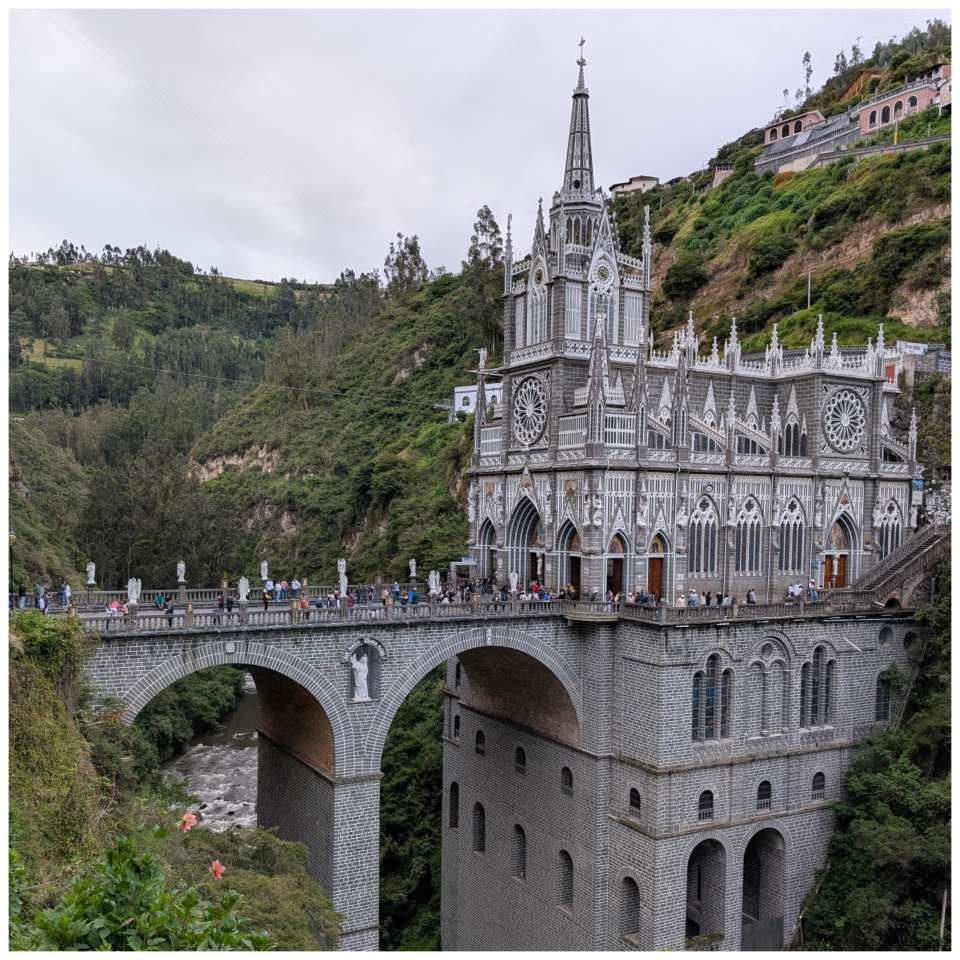
The break didn’t last long though, and soon we were on another bus heading to Pasto. We only planned to stay overnight here before taking yet another bus to Popayán in the morning. None of these distances seem particularly far, but we’ve long learned that everything here takes much longer than one might expect. In fact it also seems like everyone associated with the bus companies suffers from inability to form new memories and forgets the long delays at the end of each day. On the plus side though, it became quickly obvious to us that the buses in Colombia are much more like the ones in Peru and much less like the ones in Ecuador, meaning significantly more comfort and less bag stealing. A most welcome change.
Popayán, Colombia
After the endless buses we wanted to spend a few days staying put. We booked three nights in Popayán. It seemed like a good place to do that. It was not too big and not too small, it was meant to be beautiful, a so-called white city. I was imagining Sucre in Bolivia all over again, with a relaxed vibe and lots of cute cafes. I was wrong.
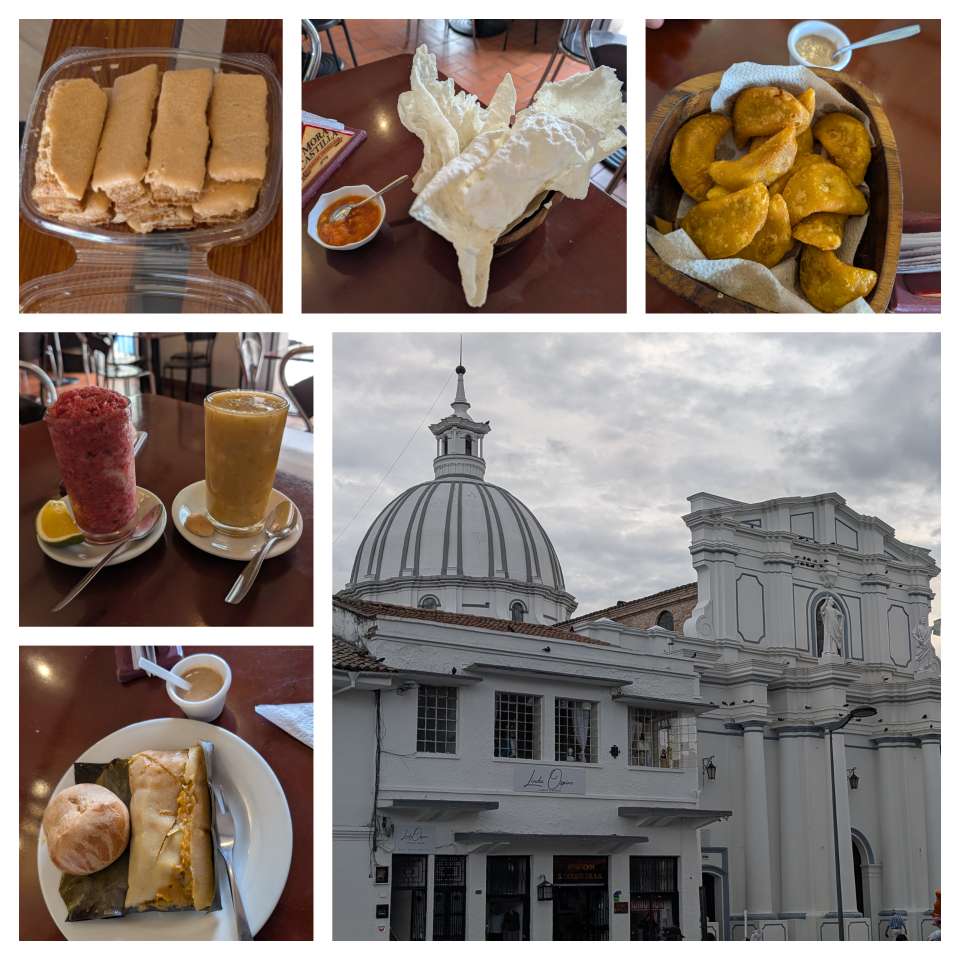
We got tired of Popayán quite quickly. Apart from trying some local food (which doesn’t take that long) there was not much to see or do. Worse yet, both in Pasto and here we felt less safe than practically anywhere else during this trip. Walking around after dark (i.e. 6pm), even in the early hours, quickly felt like a really bad idea.
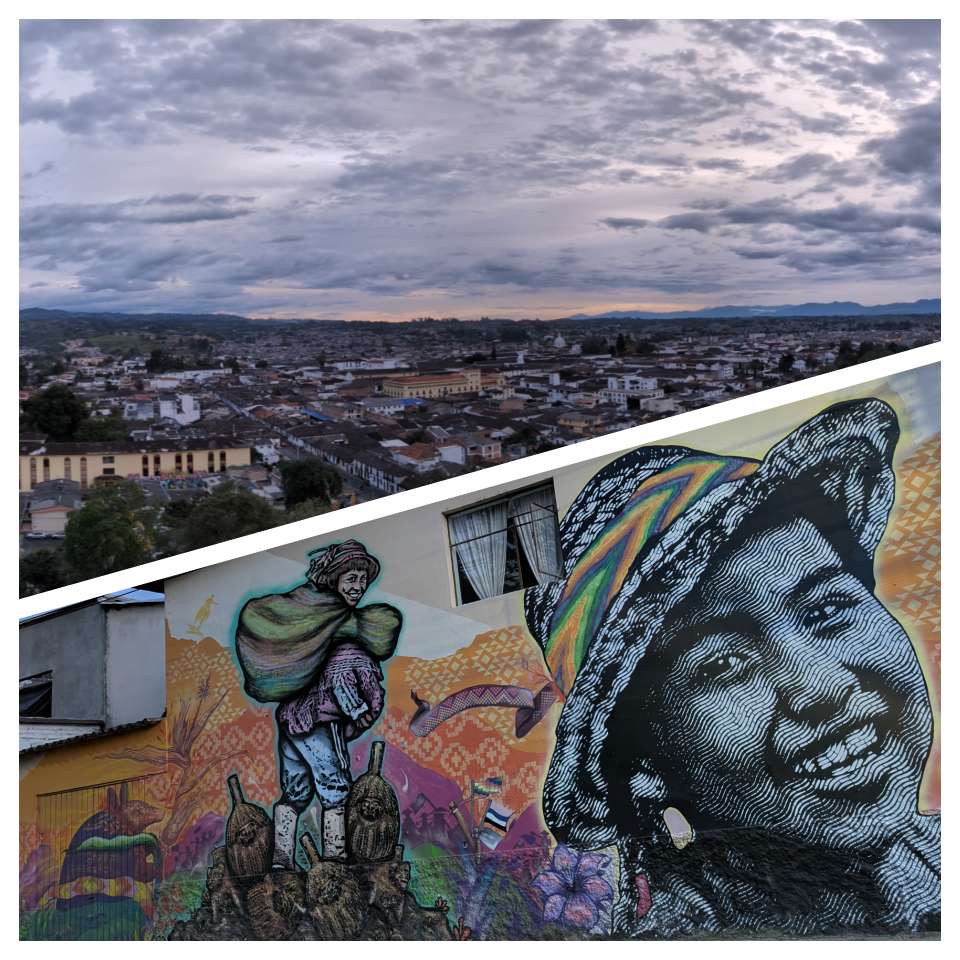
We were off to a rocky start in Colombia. We met other travellers who fell head over heels for this country, yet so far we struggled to see what all the fuss was about. But we were trying to keep an open mind, maybe the coffee region would be different!
Once it was time to head to Cali we were pretty happy to be leaving Popayan.
Cali, Colombia
Cali was just a brief stop. The main draw of the salsa capital of the world is indeed salsa dancing. The thing is neither one of us has a clue about how to dance salsa and Nathan certainly didn’t seem like he’s keen to learn now, so there was not much point in hanging around. We walked around the city a little, and from there headed up to Eje Cafetero, the Coffee Axis of Colombia.
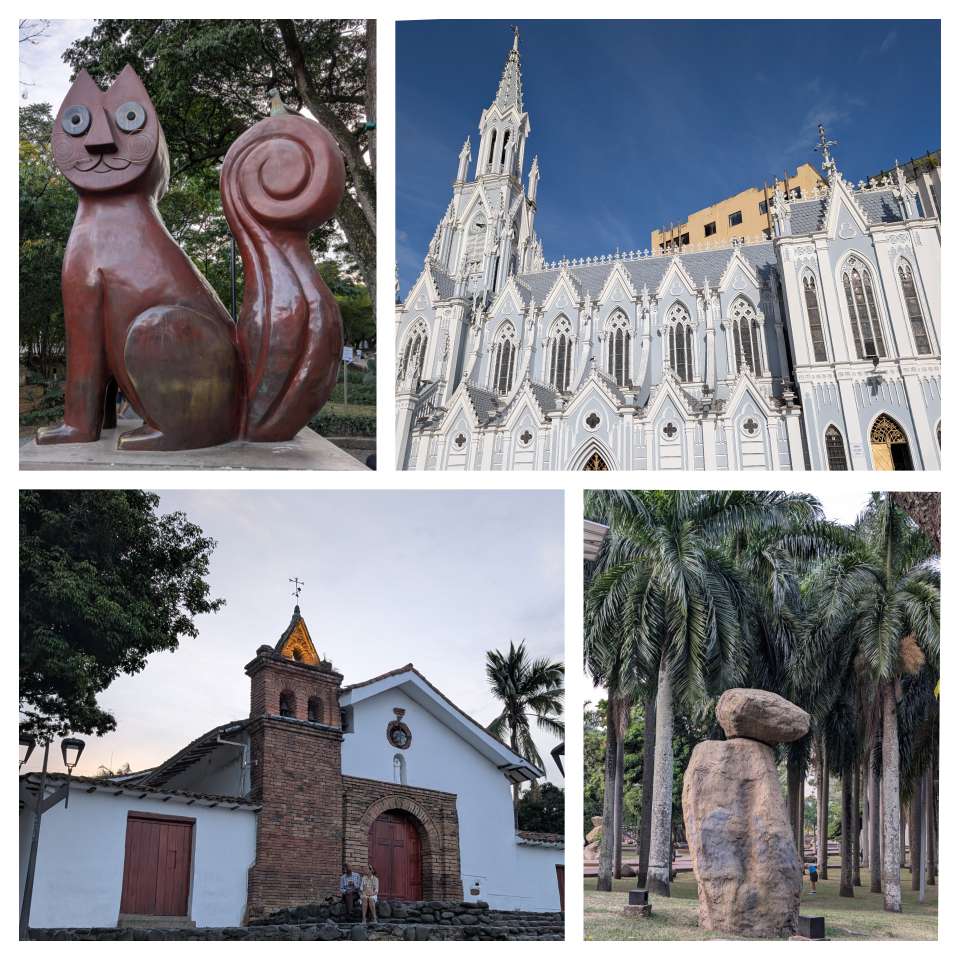
Salento, Colombia
We’ve heard so much praise for Eje Cafetero before arriving here it almost made me a bit nervous, I really felt like if we don’t like Colombia by the time we leave this region, we won’t ever like it. Luckily though, it became obvious to us why people fall in love with this place. Salento won us over, and we started to fall in love with Colombia just like all the other people we spoke to did before us.
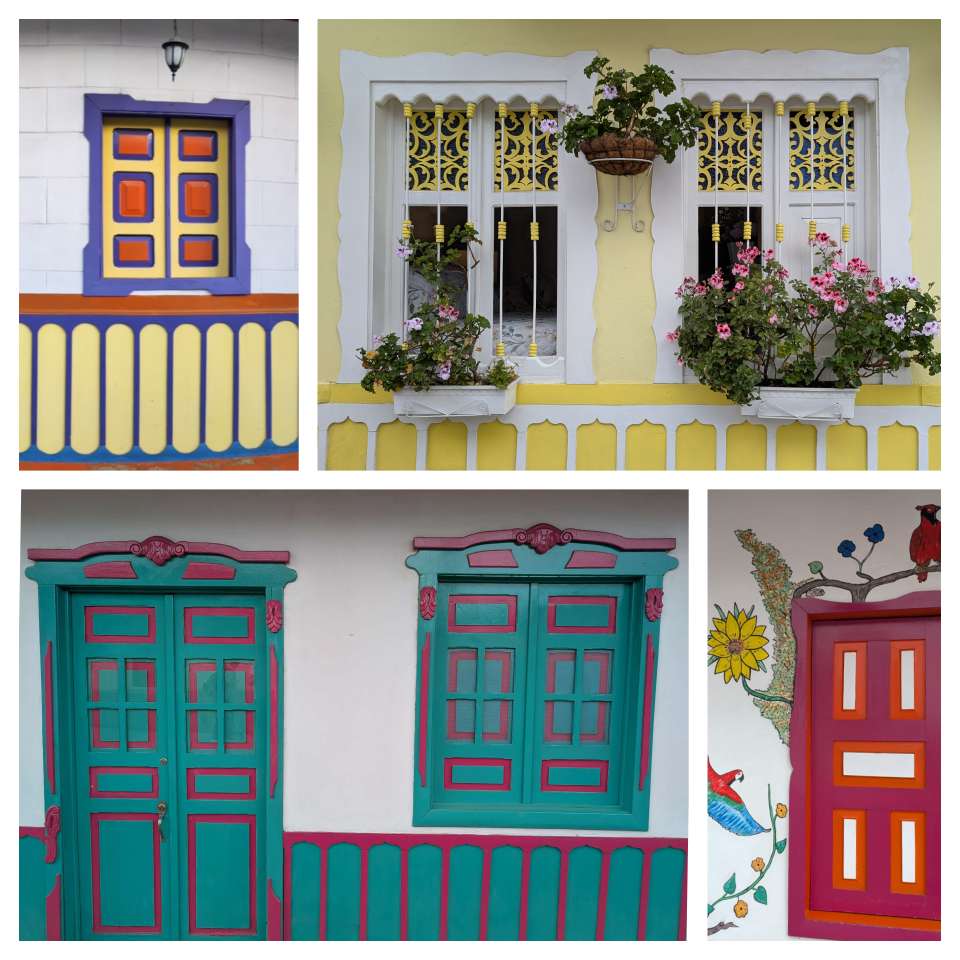
Salento was relaxed. Friendly. Safe. Cute. Colorful. Full of colonial architecture. Surrounded by nature. Tiny. Very walkable. It punched way above its weight when it came to the number of great cafes and restaurants. Finally!
We spent about three and a half days here, which allowed us a good mix between relaxing and being active. On the laid back days we wandered around the town looking at the pretty little colorful houses, and enjoyed all the cafes and restaurants. On the other hand, once we felt like stretching our legs, we went for a jungle walk in a nearby nature reserve and visited a coffee farm – a signature tour, we were in the coffee region after all.
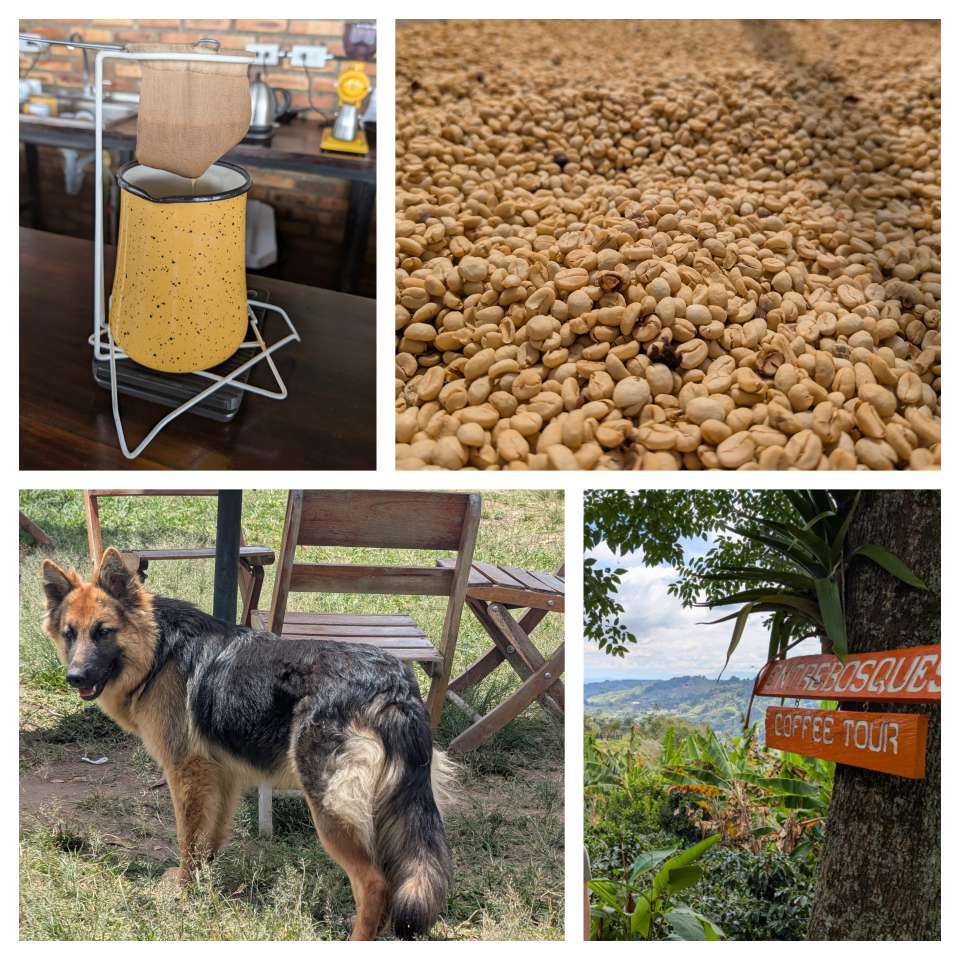

Apart from the beautiful colonial architecture, Salento is also a famous spot due to its proximity to Cocora Valley. And Cocora is home to a few thousands wax palm trees. The wax palm is special for multiple reasons – it grows nearly exclusively in Colombia, it is endangered and protected, it’s Colombia’s national tree, and it even features on the Colombian 100.000 pesos note. However rare though, we didn’t fancy a crowded walk simply to look at some trees, so we chose a different way to see them. We signed up for a mountain biking trip through La Carbonera, a more remote valley, but also a home to the largest population of these exceptionally tall palms.
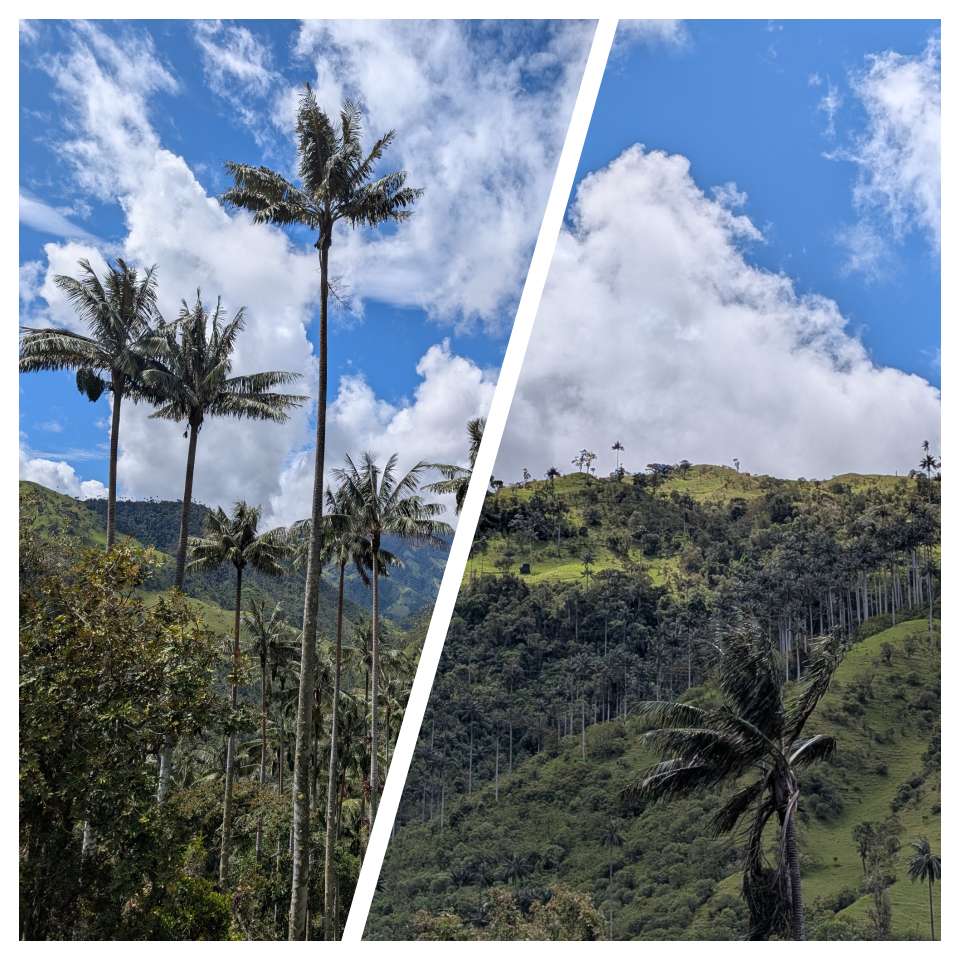
This was our first time mountain biking. We both cycle loads, but never in terrain (unless we count the London potholes, which perhaps we should). We were assured that this is a relatively easy route, we’ll start slow, and can decide our own pace. Once the group set off, Nathan and I exchanged quite a few nervous glances and comments, the main one being “this is not slow, this is literally the maximum speed I’m comfortable going!”
Whilst we were both terrified at the start, over time we learned that the bike is a lot more stable than we expected. But we both developed very different feelings towards the sport. Whilst I (carefully) started experimenting with how much I can push myself and the bike, Nathan seemed to grow increasingly tense over time, attempting to remain in full control of the bouncing bike. You can imagine which one of us enjoyed this activity more.
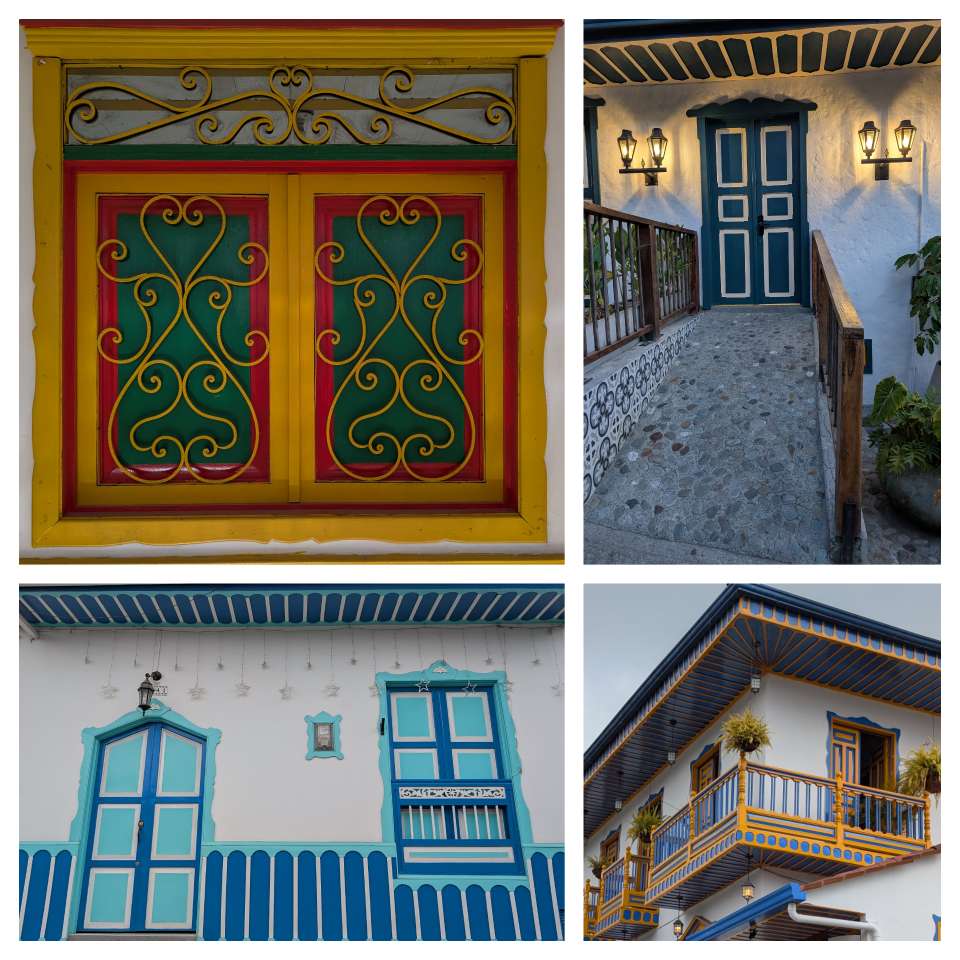
We had a great time in Salento, but the town was only small. We wanted to move on and explore more of the Coffee Axis, and our next destination was Jardín. To get there, we took a morning bus to Riosucio. We knew this was where we needed to switch onto our first chiva. I was buzzing.

What exactly is a chiva? Well, imagine a big, colorful, wooden bus often used to drive on bumpy and windy dirt roads. They have long benches, no glass in the windows, you climb in through an open entrance, they play music and most importantly they are a real spectacle. We spent many hours in this most unusual vehicle, bobbing up and down with every bump and hole in the road, occasionally barely going faster than walking speed. Since there was no glass in the windows, sometimes the people sitting on the side had to move their head to avoid a branch. My favorite part was when the “conductor”, who frequently hung off the side of the bus whilst chatting to the passengers, hacked one of the bigger branches off with a machete. Utterly hilarious.
Jardín & Jericó, Colombia
Jardín and Jericó both had a very similar vibe to Salento. We spent a few more days in them, soaking up the pretty architecture and going on walks. We found a surprisingly good Italian restaurant in Jardín, and enjoyed some excellent ice cream too. We hiked to get a good view of the Las Nubes park in Jericó.
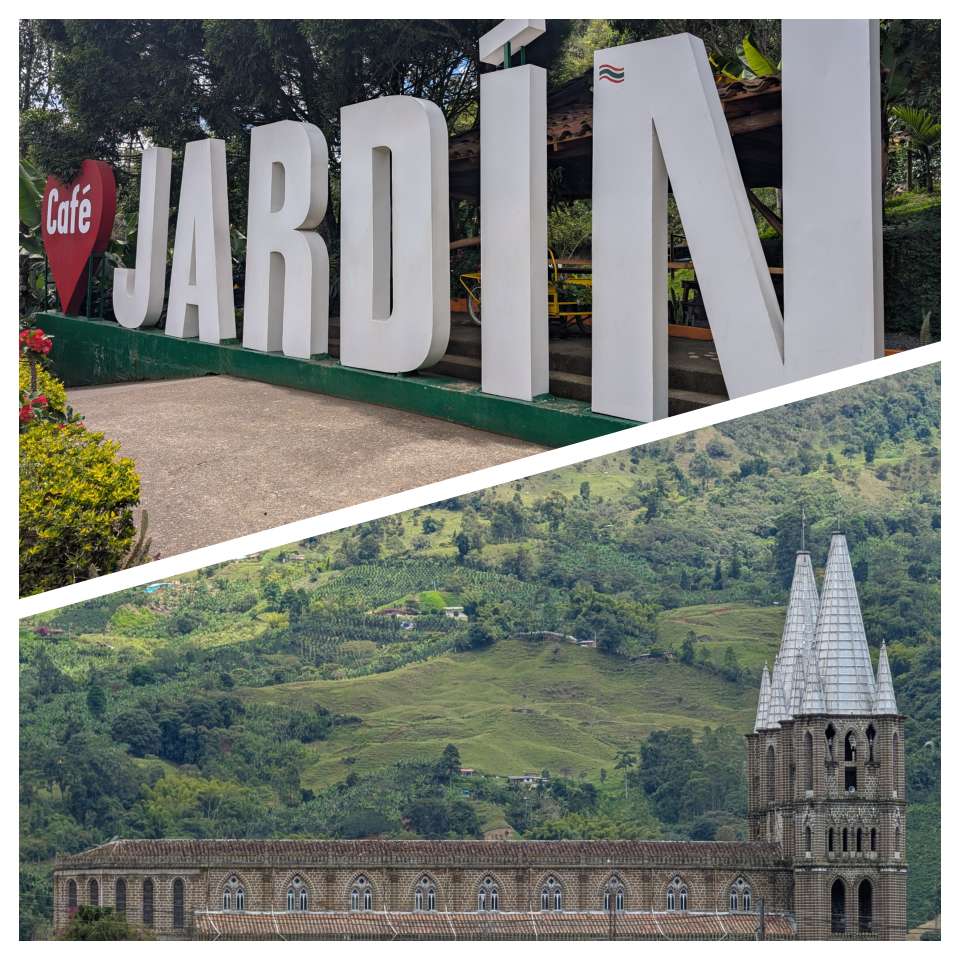
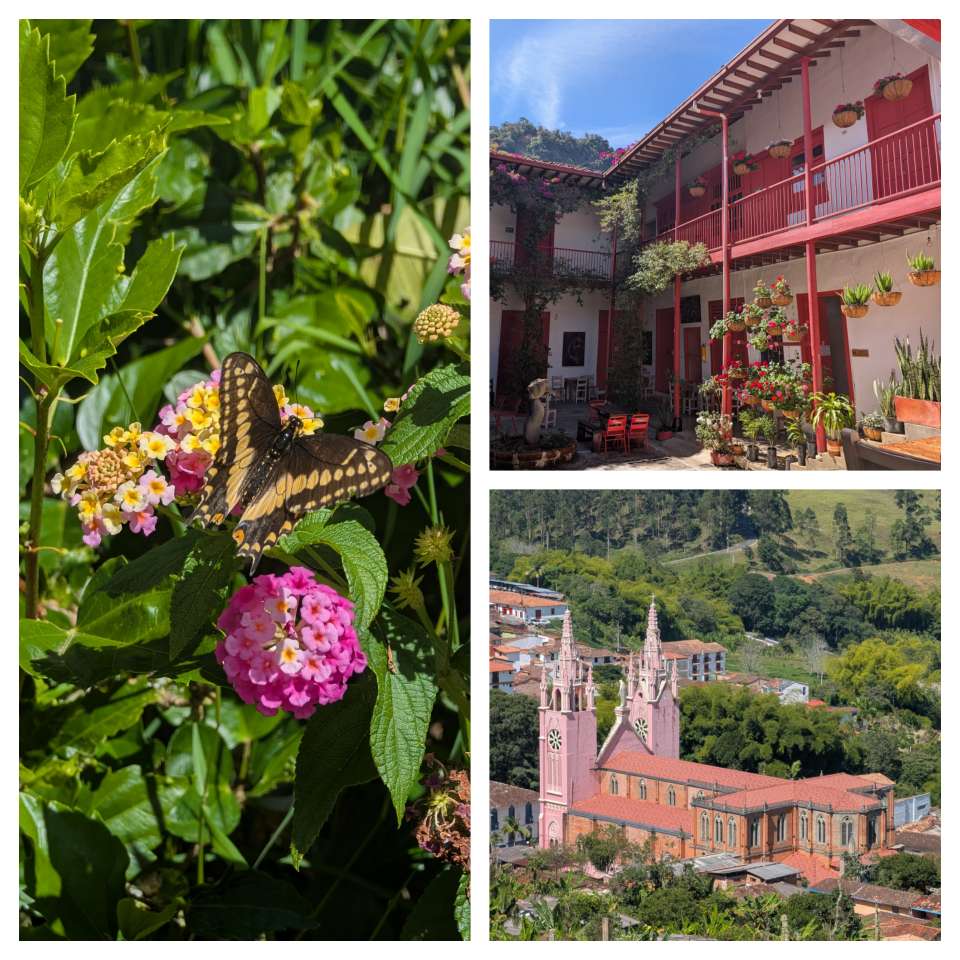
Jardín stood out with something else though. There was a natural reserve, home to the cock-of-the-rock birds. I was obviously excited. When we came here, we briefly saw one of them at the entrance gate. Once we sat down at the observation deck, for the first hour or so all we saw were trees and I was getting really worried the brief encounter at the gate was going to be the only one we’d have.
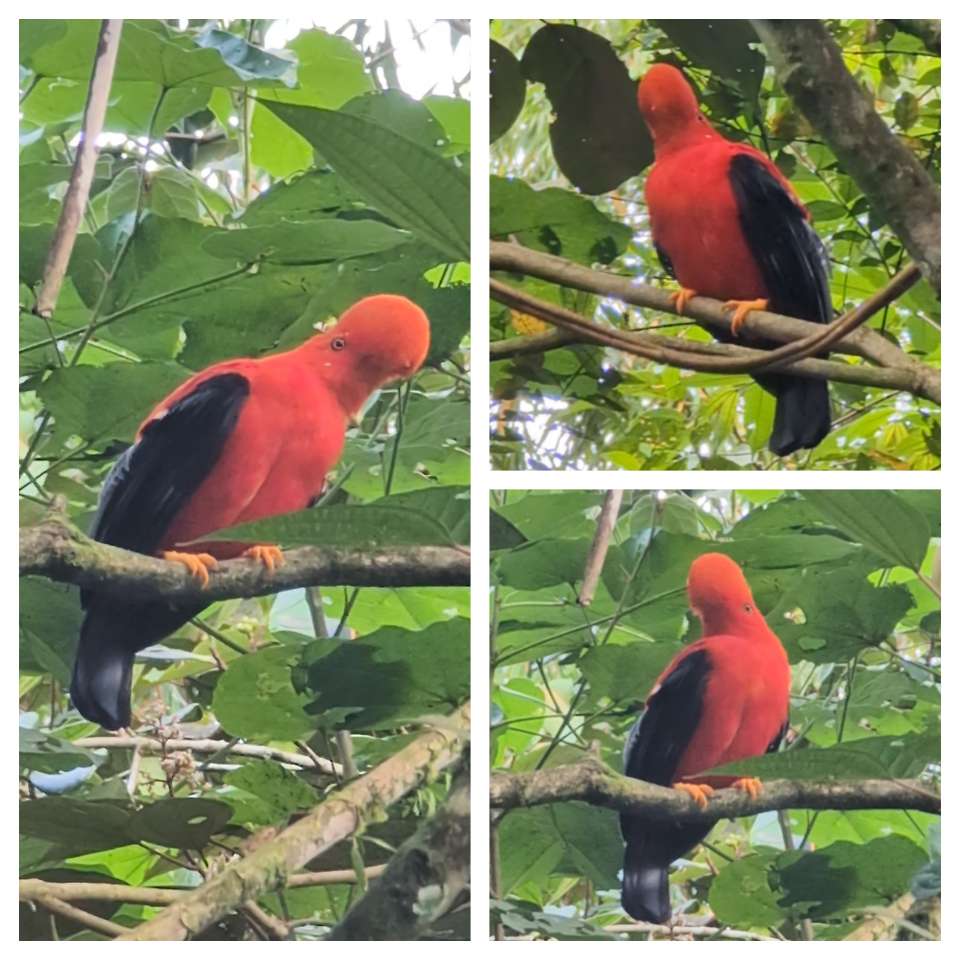
All of a sudden though one of them flew and sat down very close to me. I was so busy admiring this strange creature and trying to take some pictures, scared that it would fly off again, that it took me a while to realize it wasn’t the only one. Suddenly, there were about five or six males in our proximity. And they started performing a lek, an elaborate courtship display ritual for the females. Watching these odd looking birds vying for attention felt really special and unique. We stayed and observed until the reserve closed.
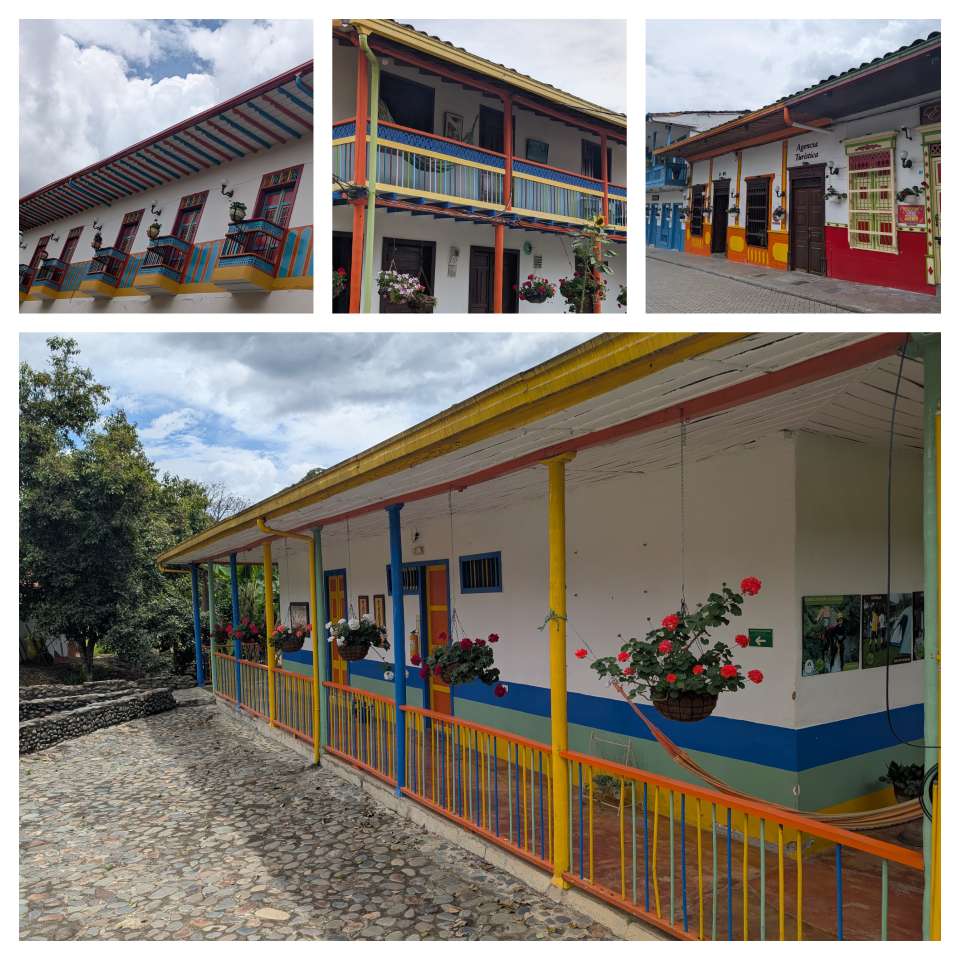
After spending more than a week in the vibrant coffee region towns we were ready for something different again. Our next bus headed straight for Medellín.
Medellín, Colombia
Unbeknownst to us we arrived in Medellín at the start of Feria de las Flores, the annual flower festival. And Medellín takes their flowers pretty seriously, so much so that they put on various events for a whole week, culminating in a final day parade showing off large flower displays known as silletas. Unfortunately, we were going to miss the grand finale, but that didn’t stop us from enjoying the other events. On our first day, whilst we walked through the riverside parks, we stumbled into a smaller parade with music and dancing. We decided to buy a ticket, and we spent multiple hours watching this jolly procession and listening to songs exclusively in Spanish which everyone but us knew the lyrics to. We did shots of Colombian Aguardiente Antioqueño with a bunch of friendly strangers, and learned little crowd chants from them. In a way it was the perfect welcome to Medellín.
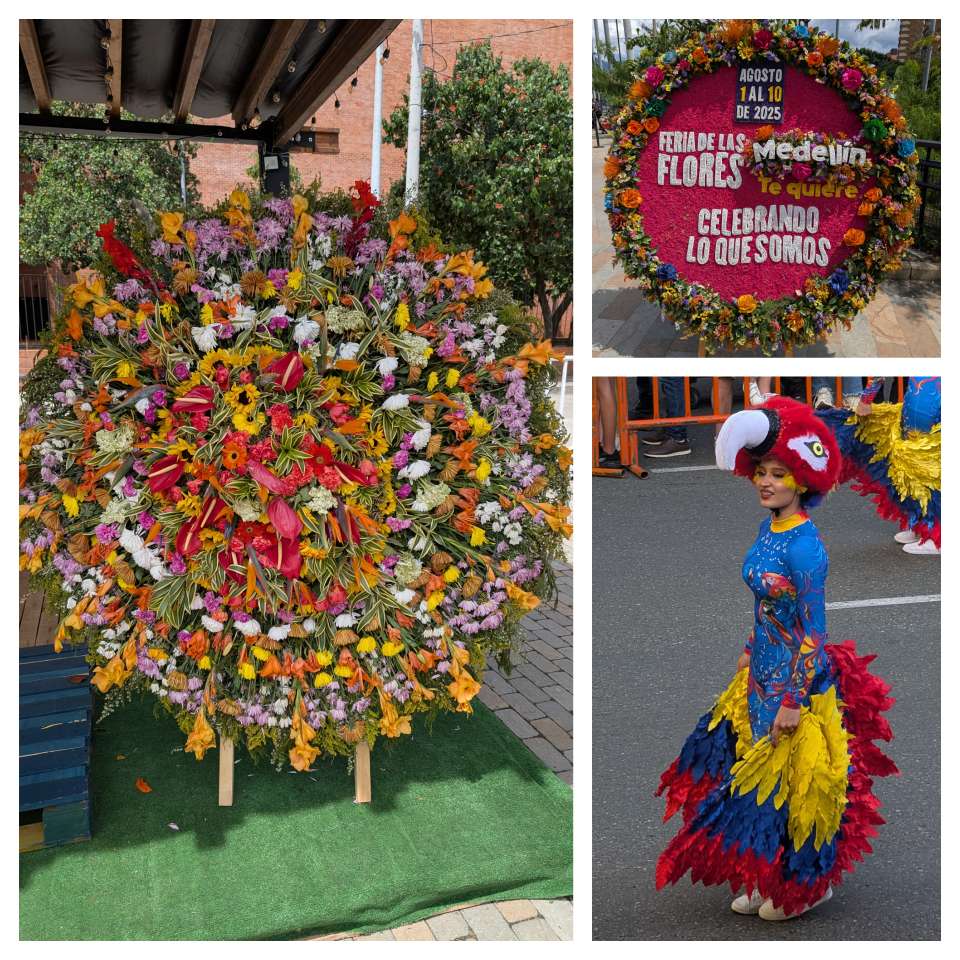
On day two, we decided to join one of the free walking tours of the city. We both started really liking these by now, it’s the perfect way to see the sights, learn something about its history, get a feel for various areas, and as a bonus get a bit of exercise too. Medellín is possibly the most interesting city to tour though, with its dark drug-entangled history, and the monumental transformation it’s undergone in the last few decades. It was genuinely fascinating to hear from someone who grew up here, and was obviously very passionate and opinionated. We felt we gained a lot more appreciation and understanding of both the city and the country, but given the complex history, we also ended up with even more questions than before.
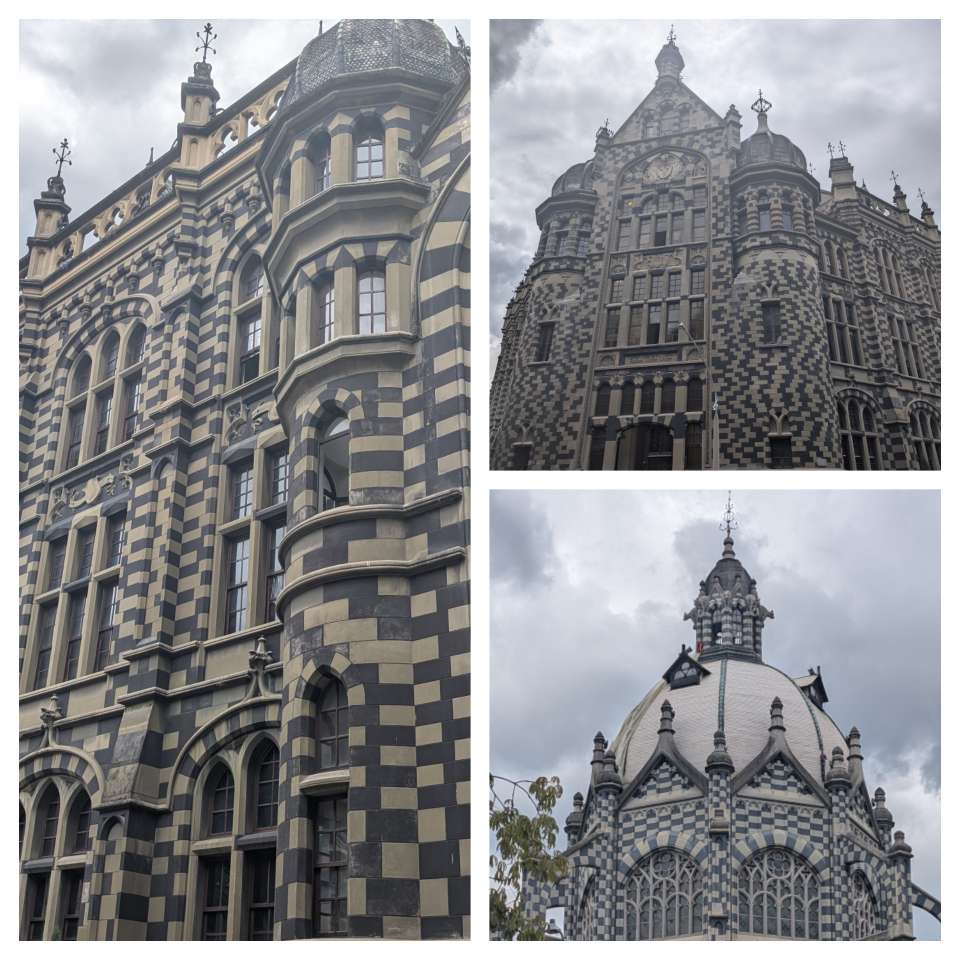
We decided to join a few more tours through some of Medellín’s districts, also known as comunas. First we visited Comuna 13 (San Javier), formerly known for poverty, drugs and violence, and now a home to an incredible transformation, a high number of street art and hip-hop, positive energy, street vendors and even impressive accessibility projects such as street escalators (the place is so hilly).
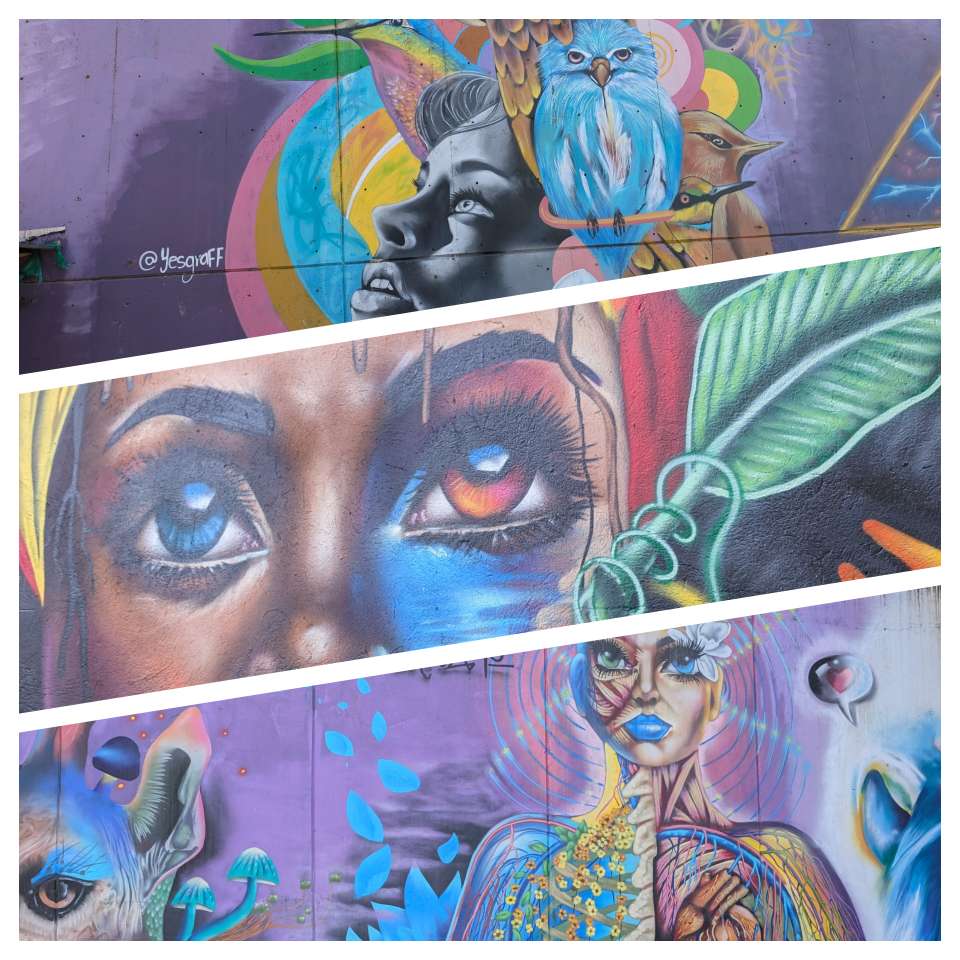
Whilst I’d not describe Comuna 13 as an authentic comuna experience, we were both glad to see it. It felt like we were in a place changed for the better, which people are very proud of, even though it transformed to what one of our tour guides referred to as Disneyland of Medellín.
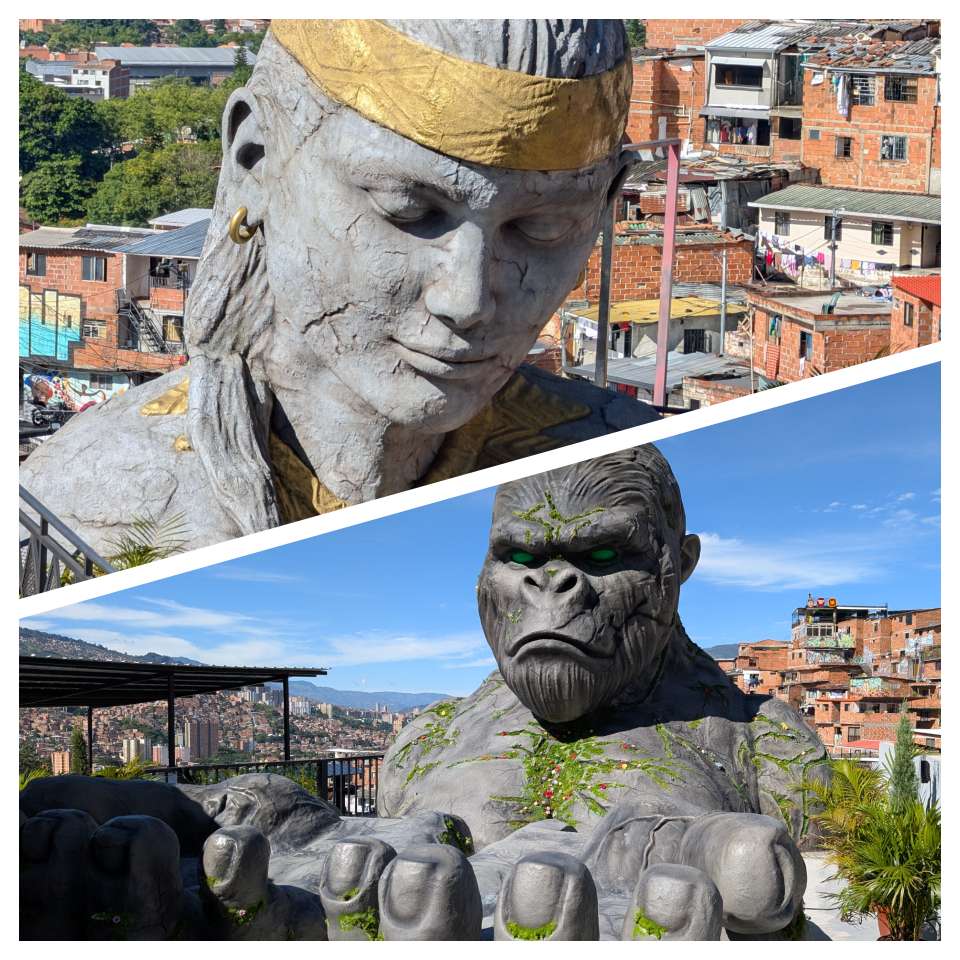
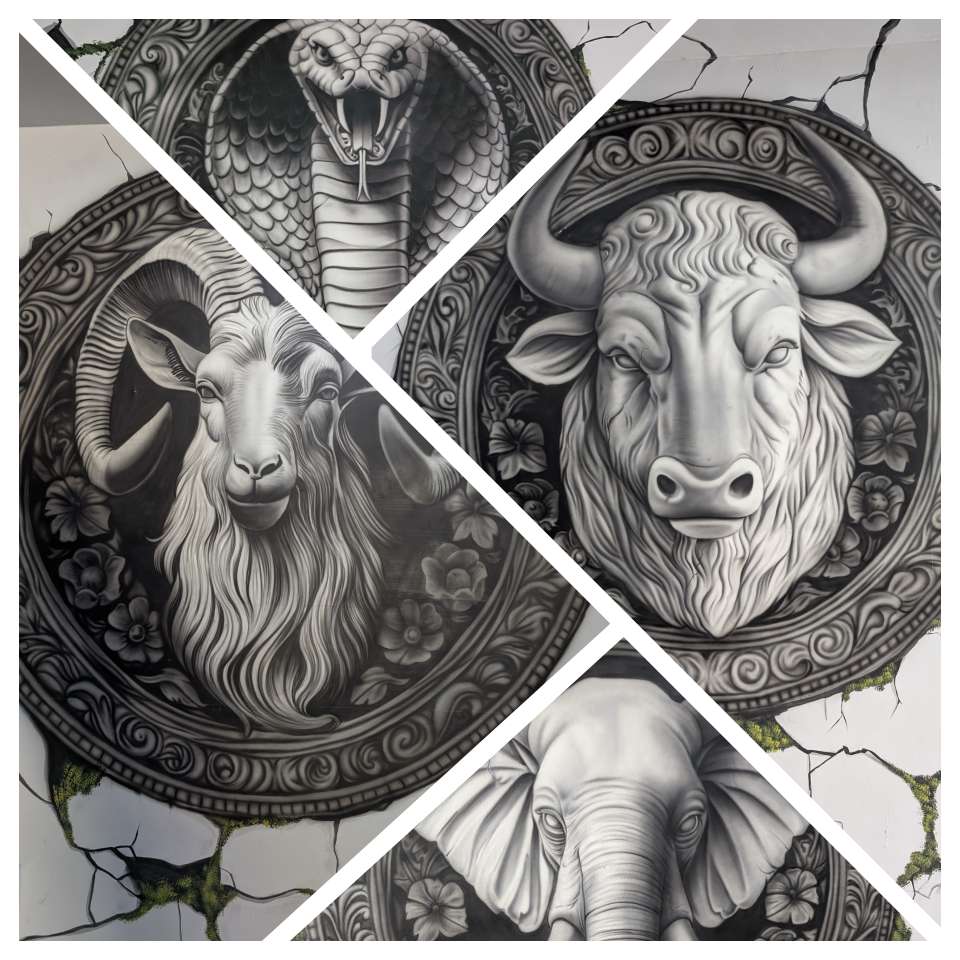
Encouraged by the Comuna 13 tour, we decided to go see Comuna 4 (Aranjuez), which was a vastly different and a more authentic experience. Comuna 4 is not a place commonly visited by tourists. The tour we joined only ran a few times a week in a very small group, in collaboration with one of the local community leaders, a sweet older lady who lived in the comuna close to all her life. We walked around the neighbourhood, with the guide mostly acting as a translator. It is one of the poorest neighbourhoods, but even here the socioeconomic differences were large. Some parts seemed like the real edges of society, with people living in small shacks, built on a literal mountain of garbage, with illegal access to electricity and water, where we were asked to not take any photographs. Some parts on the other hand seemed quite nice, like a brand new sports field, events hall, and more “regular looking” homes. We’ve learned how the neighbourhood started, improved, but also gotten worse over time, as the progression has been very non-linear. It was yet again another tour that left us with a bit more knowledge and understanding, but also even more questions than before. Colombia is a complicated country.
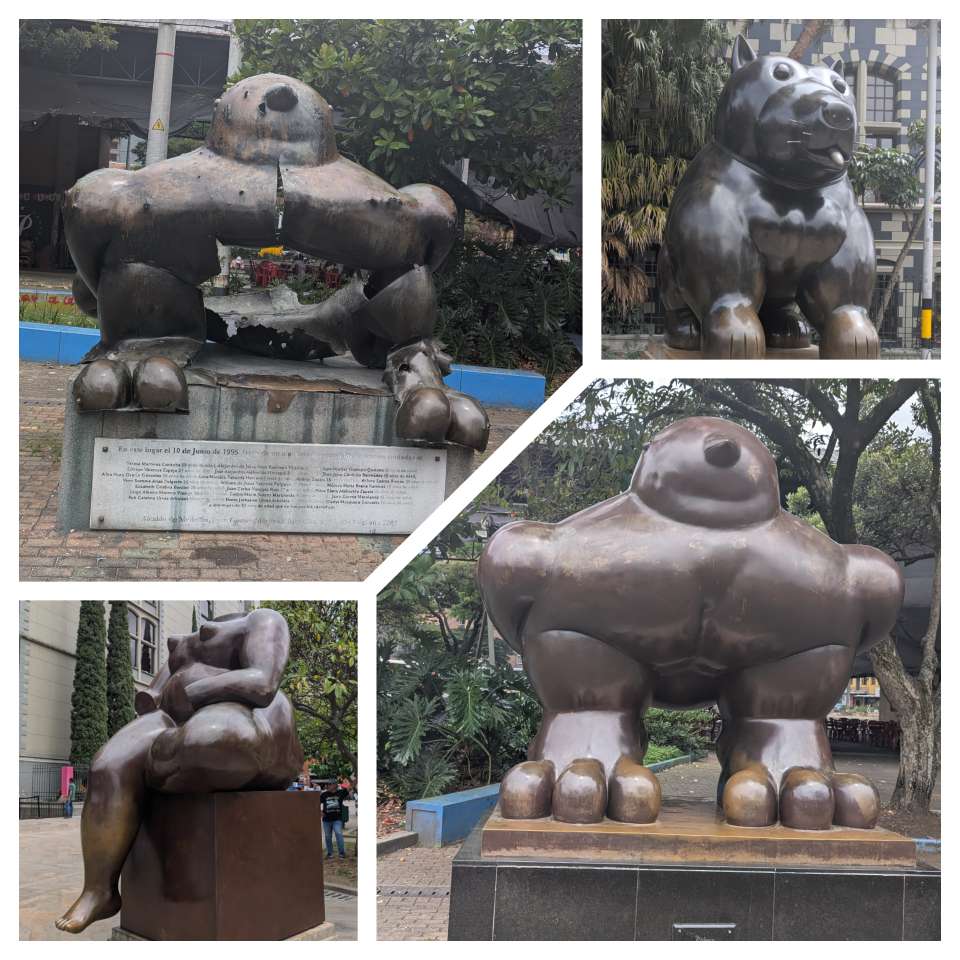
Having a day with nothing planned, we decided to imitate one of the popular fruit tasting tours. Colombia has so much weird fruit! We visited one of the local fresh produce markets, and basically bought everything that we didn’t know and that looked odd. Unsurprisingly, we ended up having kilos of fruit. We managed to get the names of some of them from the vendors, and for some of them we used the internet (and Chat GPT) to identify what it is that we actually bought. Among our haul was uchuva, zapote, lulo, multiple types of passion fruit, pitahaya, lulo, mortiño, mango, mangostán and tamarillo.
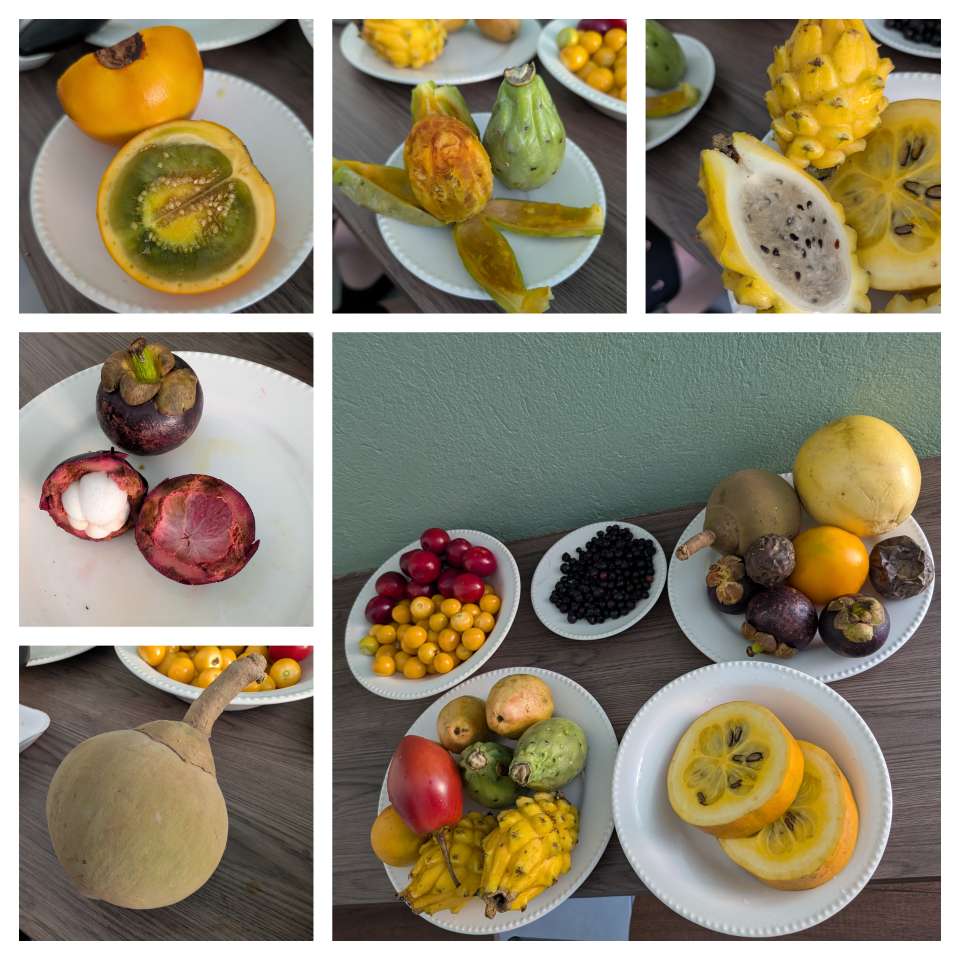
Medellín has been an eventful and busy place. Along with all the things above, I’ve also managed to get my second course of QDenga vaccine here, we’ve visited the Museum of Antioquia and had dinner whilst watching a jazz concert. We’ve been to some great restaurants, and walked around the city a lot.
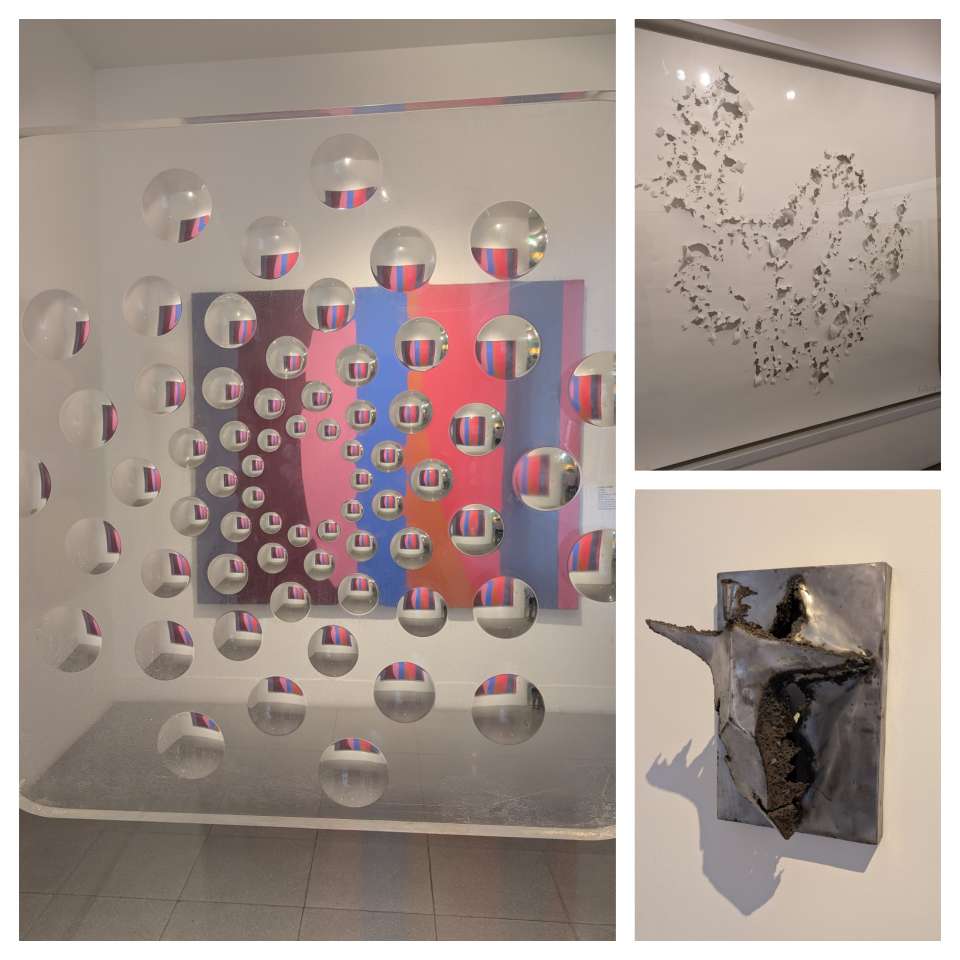
There was so much to do it felt like we could easily spend another week here, but unfortunately that was not to be. We already had a flight booked to Cartagena.
Cartagena, Colombia
Sadly, this was going to be the last place Nathan and I visited together. We decided to stay in a swanky apartment with a rooftop pool, which turned out to be an excellent decision.
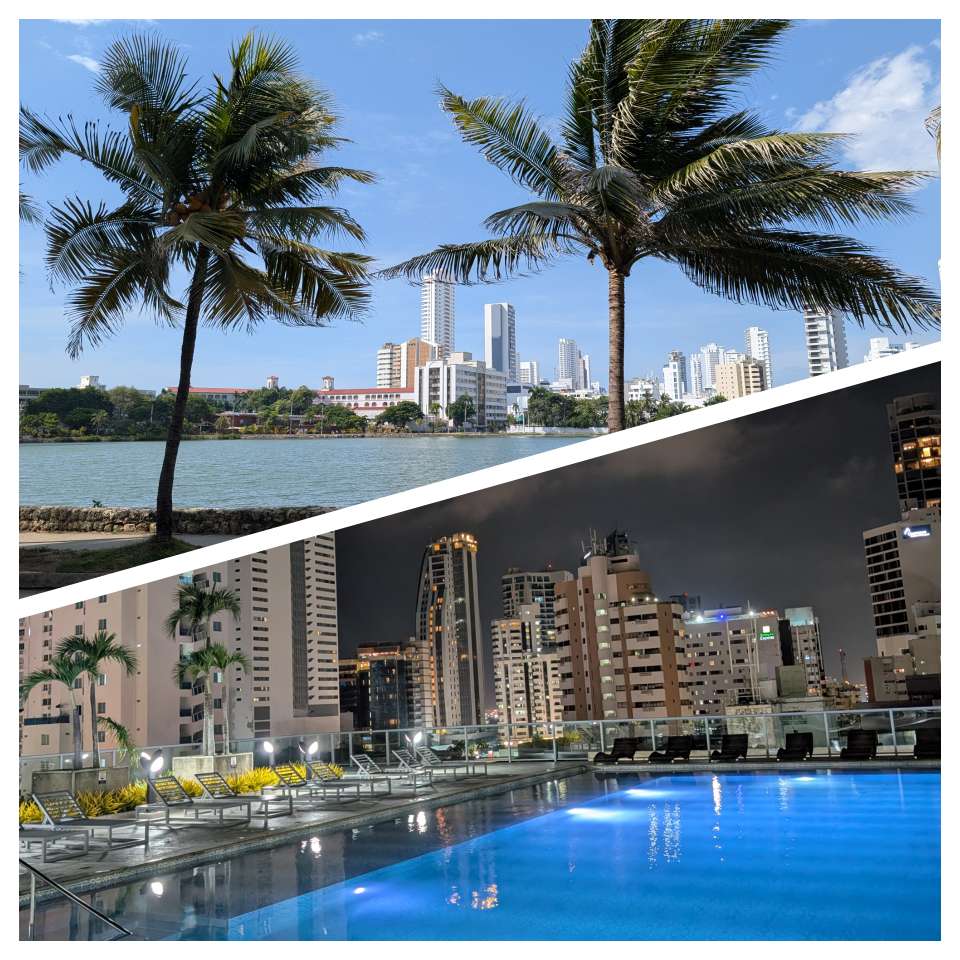
It’s easy to see how travel bloggers sing praises about Cartagena. It’s a place where beautiful colonial architecture interleaves with the lively Caribbean atmosphere, and it’s so easily accessible. But the truth is we didn’t really love it. It was too hot and way too humid. It was a strange city with an invisible divide between the tourist parts and the parts where locals live, seemingly never mixing. It was overpriced. And most annoyingly you really couldn’t walk down the street without someone trying to sell you something every five minutes. The offered goods ranged from a spot on a sunlounger on the beach, to sunglasses and drinks, all the way to cocaine.
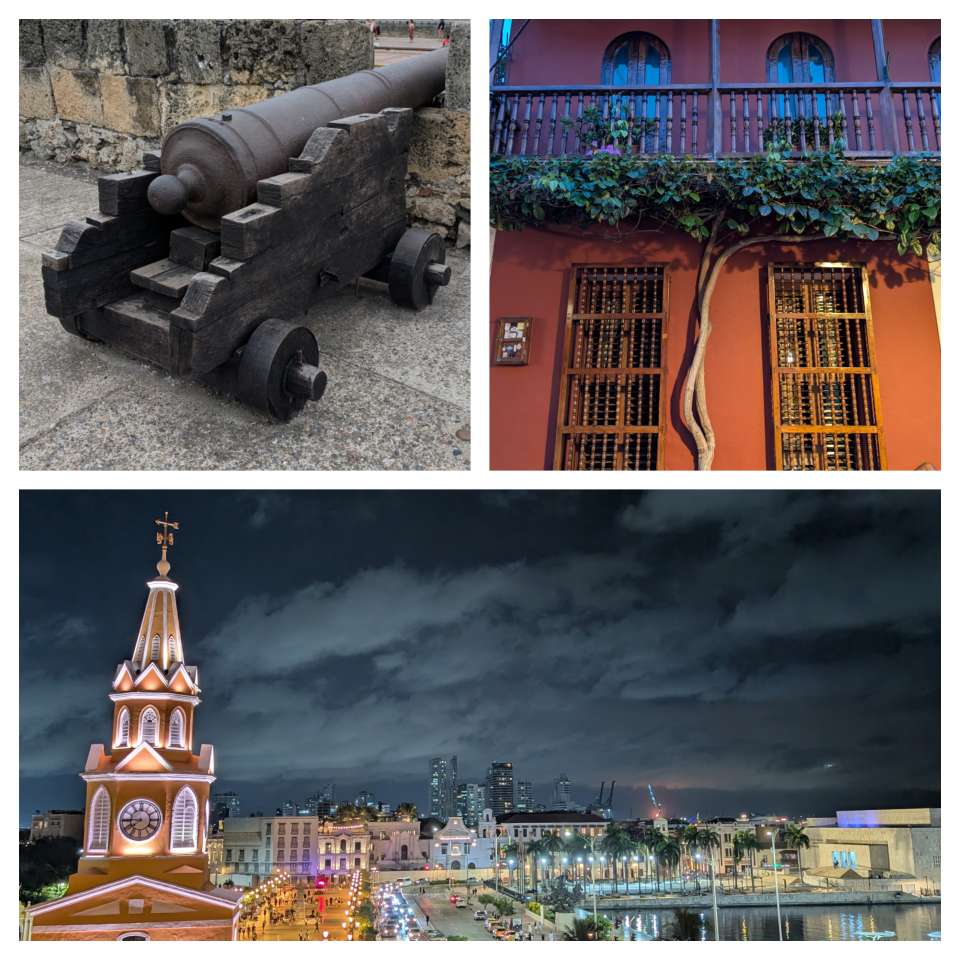
Regardless of not liking the city as much, we still made the most of our stay here. Our highlight was dining in a really nice restaurant for Nathan’s birthday. We’ve also joined a walking tour and visited the naval museum. And we spent a lot of time in the private pool and sauna at our apartment complex, which was a lot more relaxed than the beach.
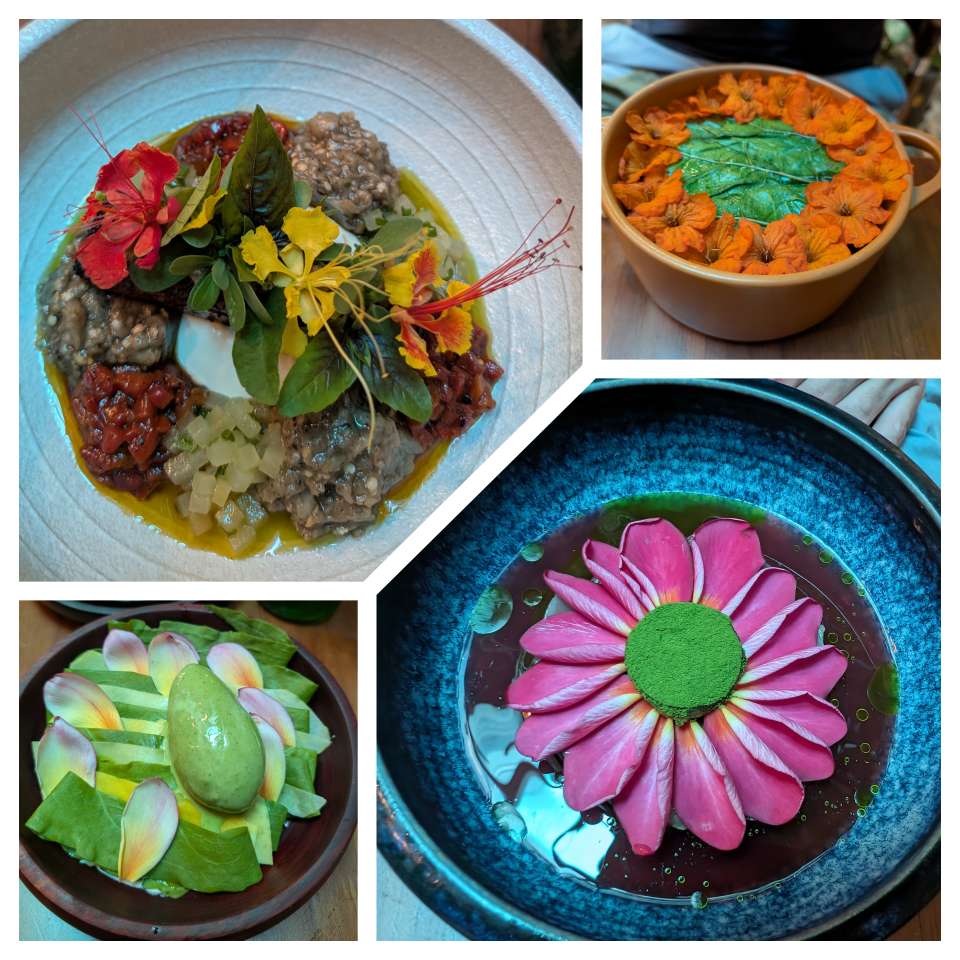
Inevitably, the time came for Nathan to abandon me. It was a warm evening, we kissed goodbye, and each took a separate taxi. I went to my new hostel, and Nathan to the airport. It’s hard to believe that we’ve traveled together for three months already, and even harder that I’ve been gone for more than four now. A part of me thought it must be a lie… but then we’ve seen and done so much, that in some way I know it’s undeniable.
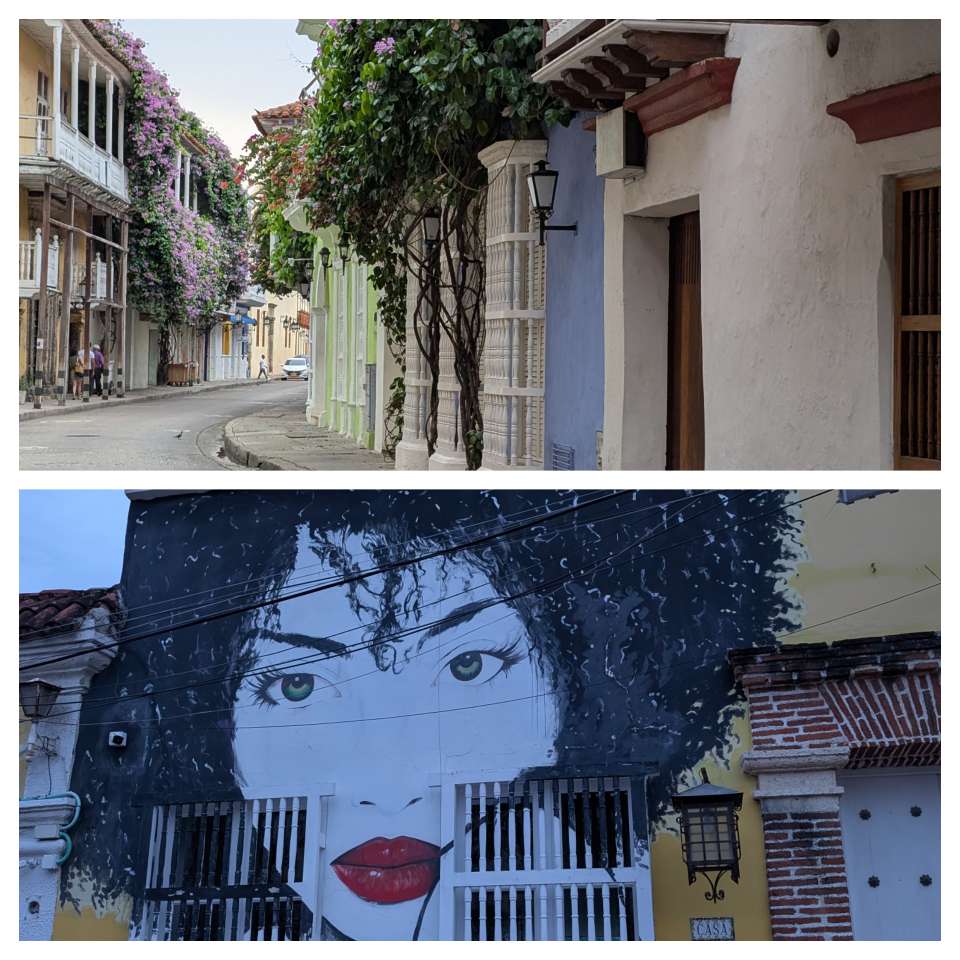
It was sad to say goodbye. But I decided not to pointlessly sulk and wallow, and instead I already planned out my next steps. After one more night in Cartagena I took a bus to Palomino.
Palomino, Colombia
The bus to Palomino took practically the whole day. I was very glad when I finally arrived in this small seaside town. The crowd that gathers here is very relaxed, people often come here either for surfing or yoga. I’ve only spent two nights here, but I loved it.
Palomino was quite hot, but not nearly as humid as Cartagena has been. And the sea breeze cooled you down. It was so small, there were only dirt roads. It had lots of vegetarian restaurants. My hostel with its incredible pool was surrounded by green vegetation everywhere, it felt like there was nothing else for miles. Also, there was a puppy.
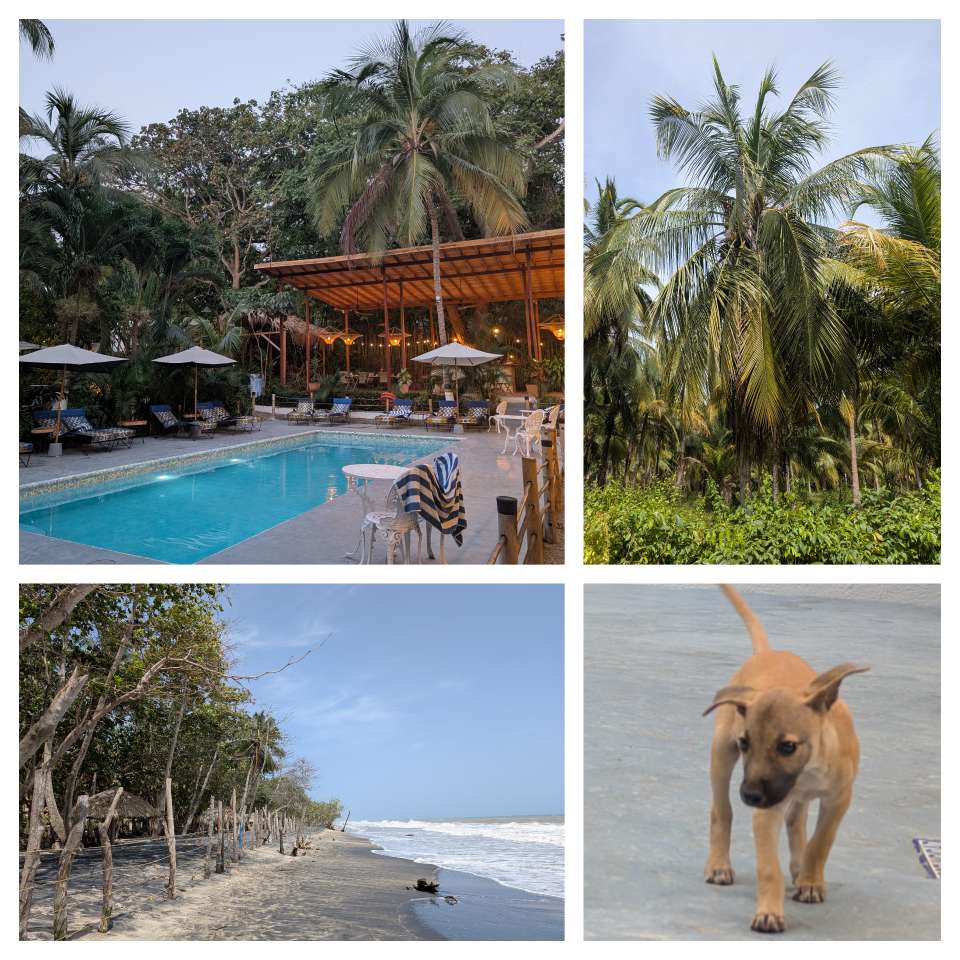
During my free day, I walked on the beach, and found a nice shady spot, all alone, to read. It’s been a while since I read something. You might question why, surely I should have loads of time. And whilst that’s true, I’ve been spending most of the downtime I’d normally allocate to reading by watching Spanish course videos instead. But I really longed for a book now, and it was the perfect time for it.
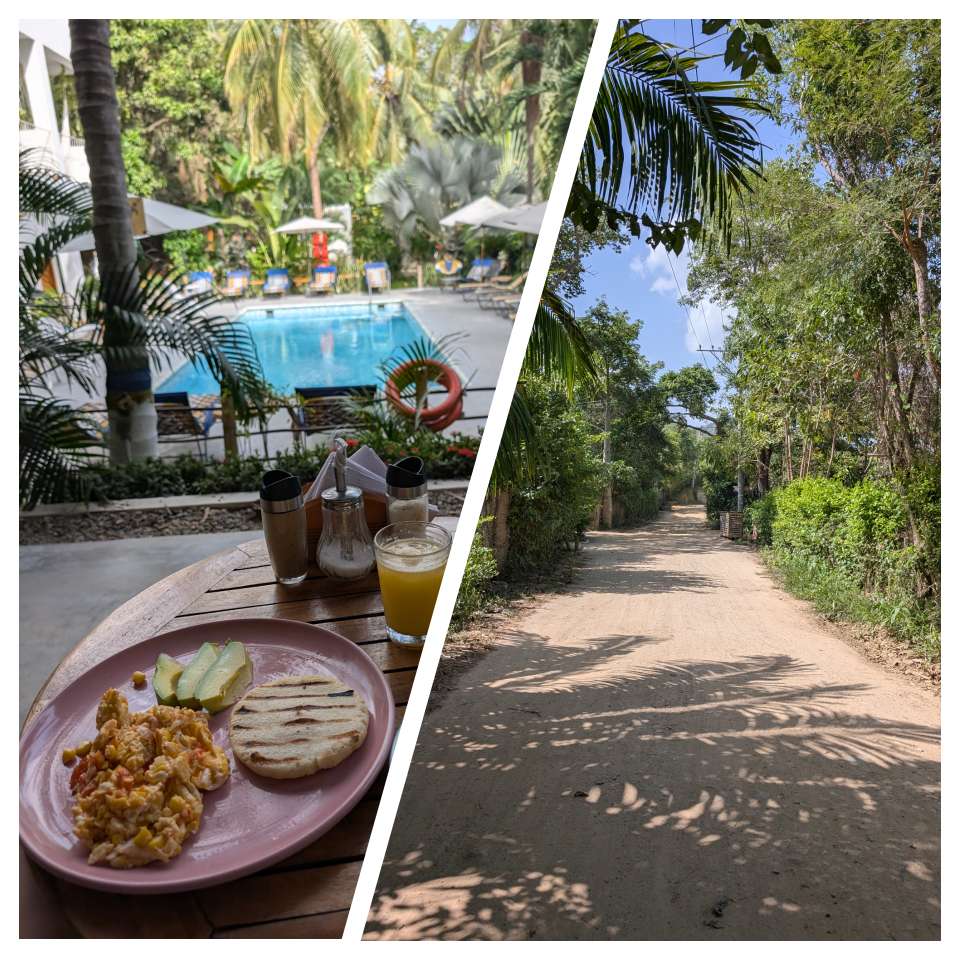
Many hours had passed with me lying on the beach and reading. I only realized this once the wind picked up and I started to feel like I’m practically eating sand. I walked back to my hostel and continued reading by the pool instead. Of course I enjoyed a good swim too.
After a very relaxing day, I packed my bag again and headed to Minca.
Minca, Colombia
In some ways, Minca was quite similar to Palomino, as long as in your mind you swap the beach for a jungle. It’s a tiny town with not much in it and I was staying in a hostel remote even by Minca’s standards.
To get to the hostel I had to take a motorbike taxi. Now, I’m not unfamiliar with these, I’ve spent six months in South-East Asia before! With my bag on the handlebars and obviously no helmet, we set off up a fairly steep hill, with lots of mud and water everywhere, narrowly avoiding the branches sticking out around us. I have slightly questioned my choice of accommodation, especially when the thick rain started pouring down in the middle of this journey. However, once we arrived it was all more than worth it. Whilst in Palomino I felt like there was just nature and no one else around, in Minca that was actually true.

The views over the hills with their lush jungle were something else, not to mention you could enjoy them whilst swimming in a pool. The sunset was beautiful too. And as a cherry on top, the hostel had an incredible vegetarian restaurant – I expected to have to go down to Minca to eat a few times, but in the end I never bothered.
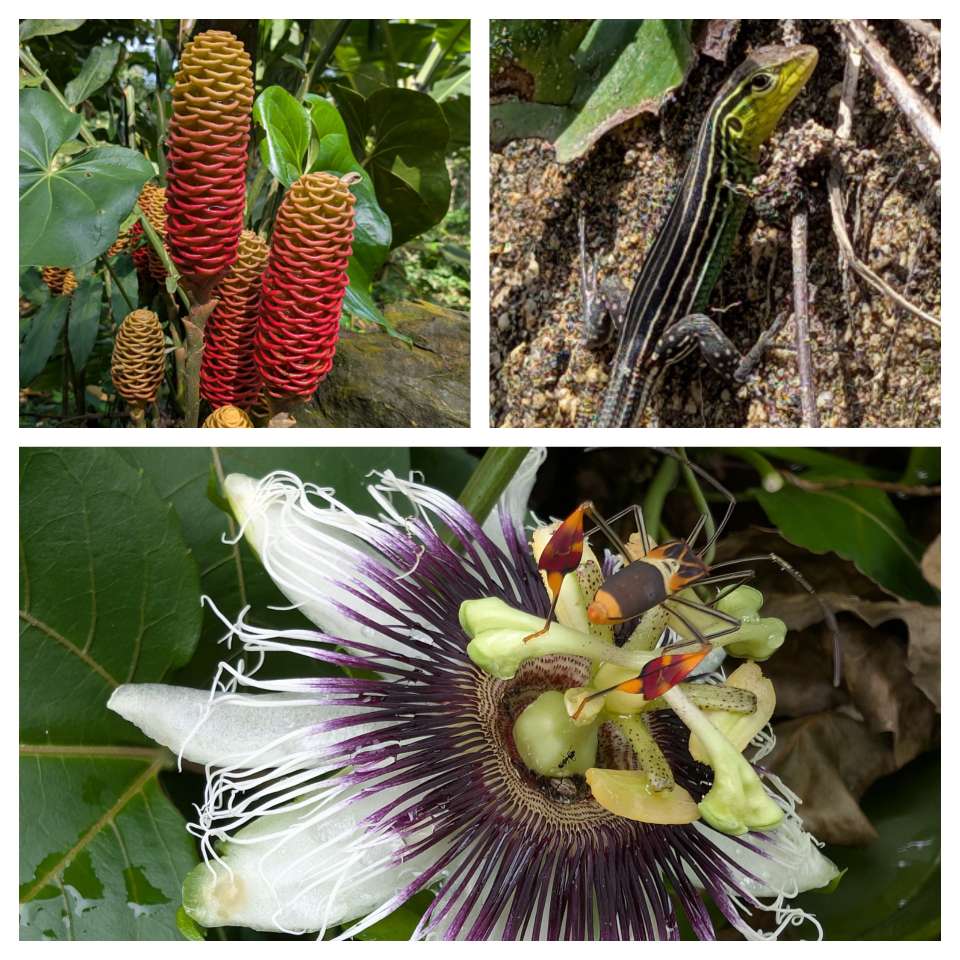
I was going to spend one of my days hiking and visiting a few waterfalls. I set off in the morning. About an hour into the hike, the path was crossing a private property, which the locals let you pass for a small fee, as is quite common here. I started looking for my wallet, and immediately felt a sense of dread. I didn’t remember taking it from the hostel. Indeed, it turned out I left without it. As I was fumbling through my backpack looking more and more desperate and evaluating my options, none of which seemed appealing, a couple I had previously seen in my hostel came up behind me. They asked if I was ok. Sheepishly, I said no and explained my predicament. They didn’t give it a second thought, paid my fee, and even gave me some more cash in case I needed it later. I was obviously feeling extremely grateful for this act of kindness, and later that night returned all the money and we had a good laugh about everything.
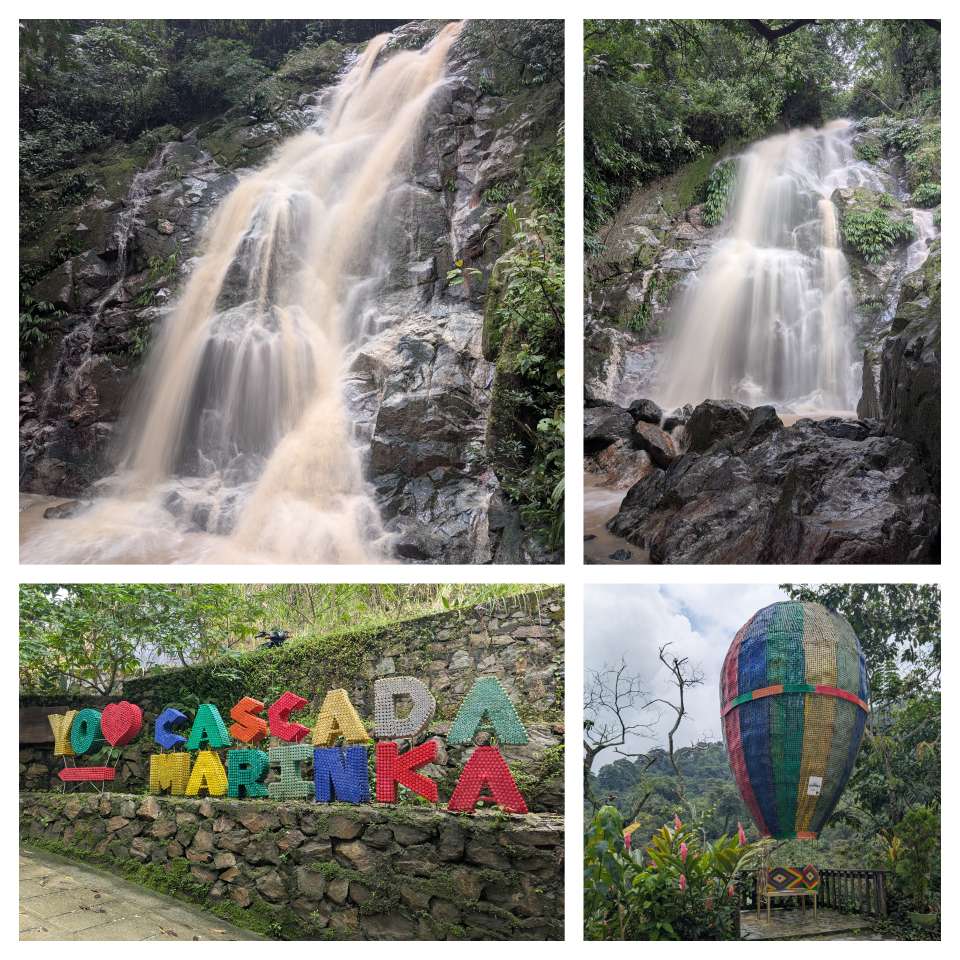
The day actually ended up being a bit of a disaster. Apart from forgetting my wallet, I also slipped when trying to cross a river, so my shoes were completely soaked and my legs covered in bruises. Once I arrived at the waterfall, I was told that it’s not possible to swim in it right now, and the rain water made it all muddy and brown, so it was hardly a sight to behold. Finally, after walking for about 18km, I was feeling stubborn, and I concluded I don’t need a motorbike from Minca back to the hostel, and instead decided to walk up the steep hill myself. I was hiking after all. Suffice to say I felt like I have never been more sweaty in my life, and I also ran out of water. Sigh.
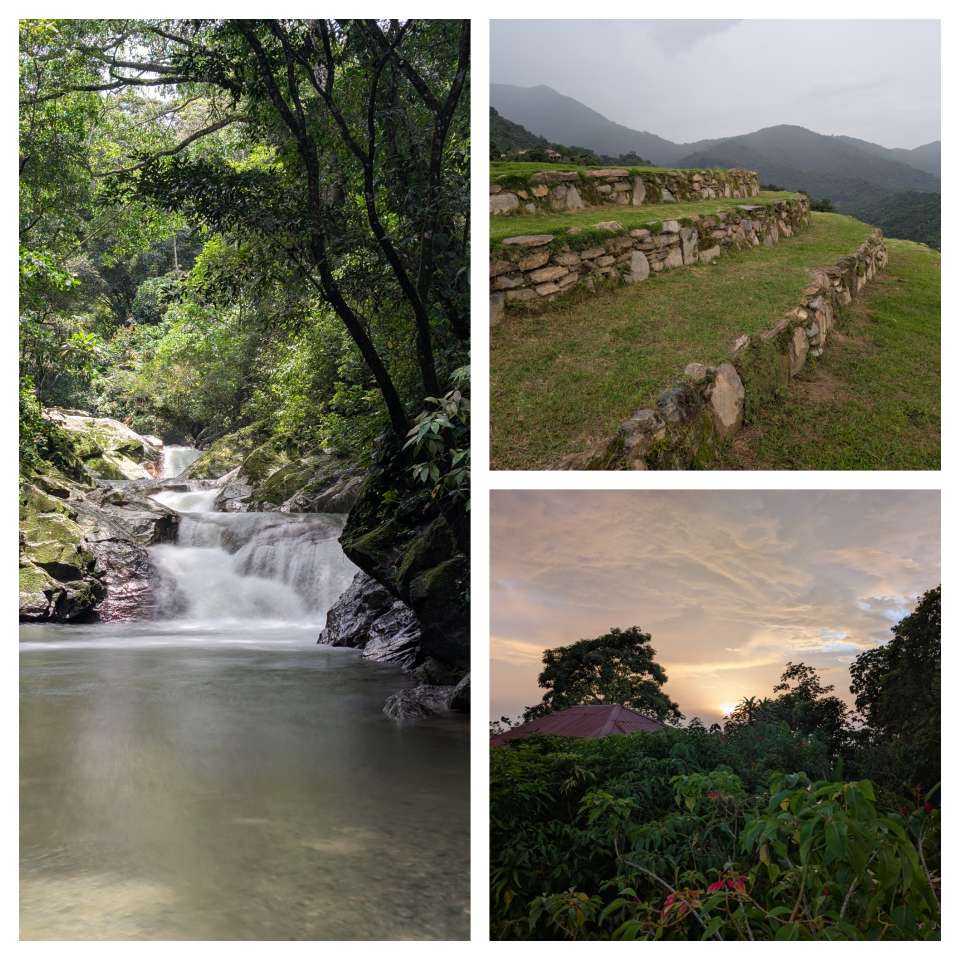
I can’t really explain why, but after all this I still felt like it was a really good day. I was exhausted, but in a good way. I cooled off in the pool with the beautiful views and then had a hot shower just in time for a delicious dinner, and a quiet night of deep sleep. What more can one wish for.
The next day turned out to be very rainy. The gorgeous views disappeared, replaced by mist and fog, and there wasn’t much to do but lie in a hammock, catch up on talking to people I’ve slightly neglected in the last few weeks, and read again. Not that I can really complain about any of that.
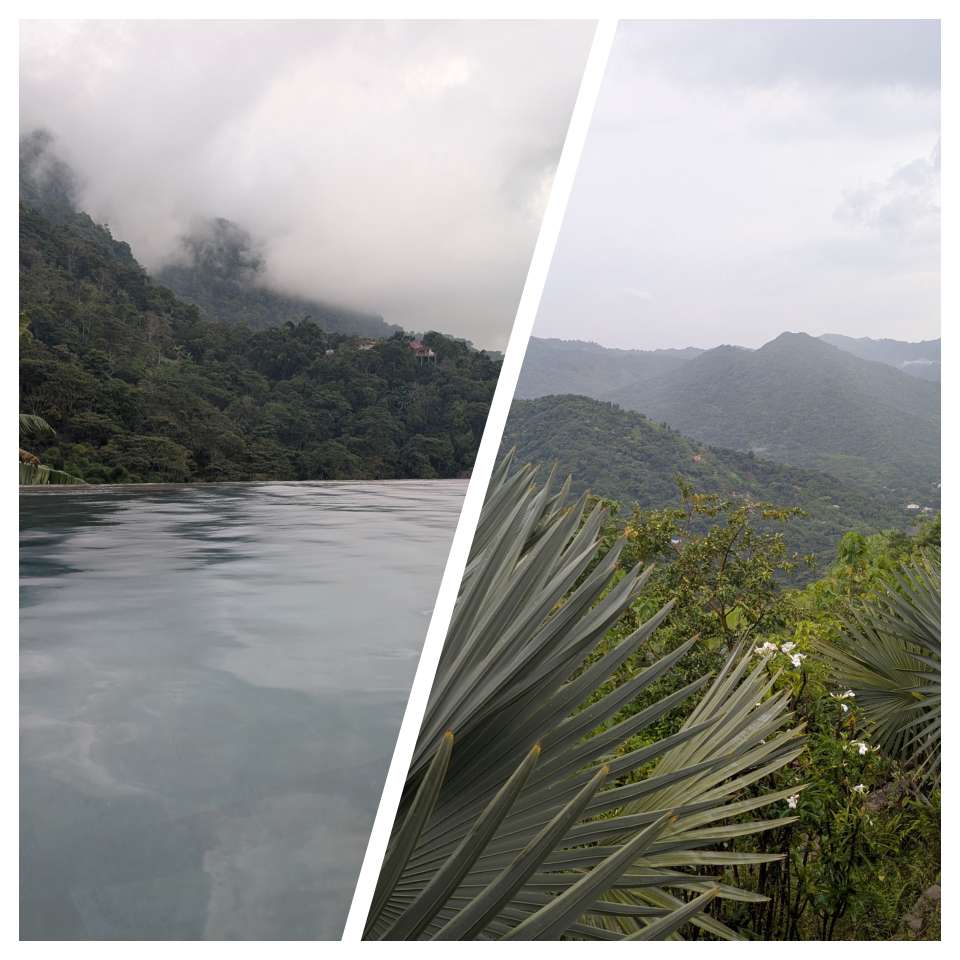
I felt sad to be leaving Minca the day after, mostly because the weather improved again and I couldn’t get enough of the stunning vista. But I had a flight to catch. I was going back to Medellín. Why? Well, long ago I decided to learn some Spanish on this trip, and Colombia is meant to be the perfect place for it. I expected to end up in either Medellín or Cartagena, but after visiting both it was really easy to choose. I’ve signed up for two weeks of lessons here. In truth I am kind of looking forward to having a bit of a routine again and not having to constantly move. Let’s hope I learn something too!